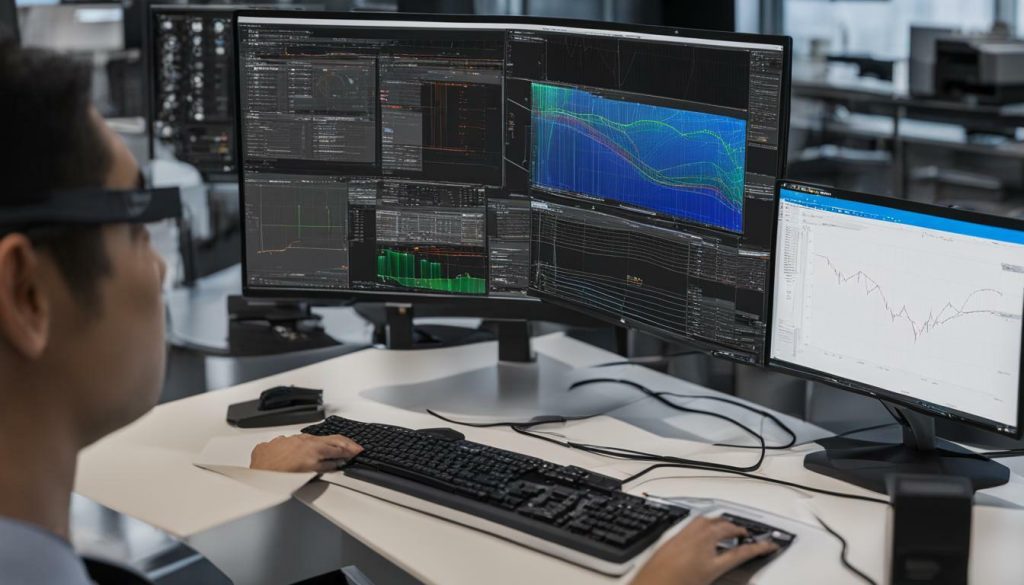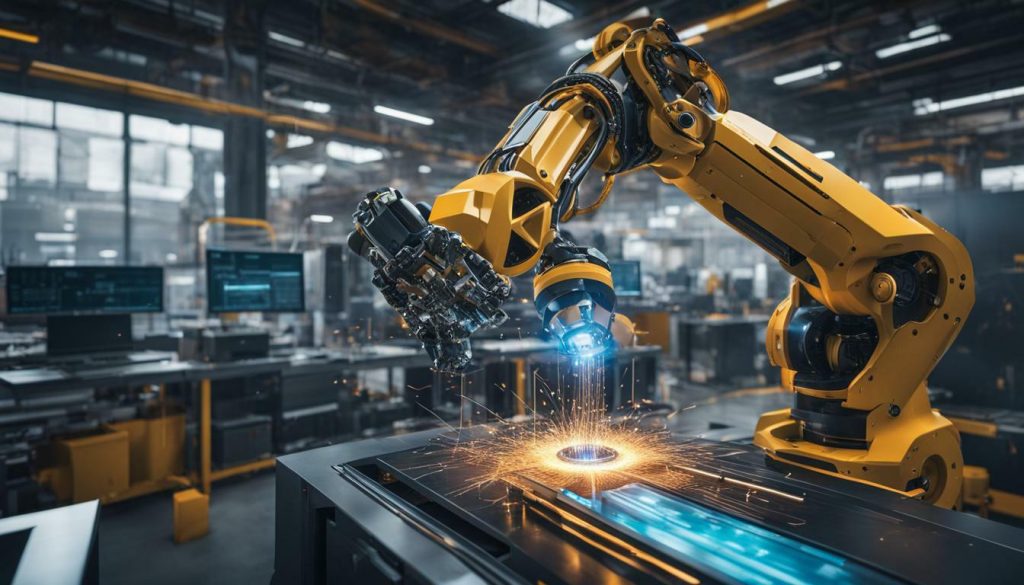
The engineering industry is undergoing significant changes and advancements fueled by digital technologies and the need for product development capabilities. These transformations are reshaping the engineer industry trends, paving the way for new possibilities and innovation in the United States engineering sector.
In this article, we will provide a comprehensive insight into the latest engineer industry trends, examining current advancements and forecasting future developments. From the impact of simulation in engineering to the adoption of AI and machine learning, we will explore the key areas driving change and shaping the future of engineering.
- The engineer industry is evolving rapidly, driven by digital technologies and product development needs.
- Simulation plays a critical role in engineering, enabling virtual testing and validation.
- AI and machine learning are being increasingly adopted in the engineering industry, but integration is still in the early stages.
- Engineers play a crucial role in developing AI systems, optimizing instructions, and creating meaningful interactions.
- The engineering industry is experiencing trends in sustainability, climate resilience, virtual public engagement, and innovative land developments.
- These trends present opportunities for innovation and growth in the engineering industry.
The Impact of Simulation in Engineering
Simulation has become a critical aspect of engineering, allowing for virtual testing and validation, with technologies like digital twin reshaping the simulation value chain. This transformation has been driven by the need for product development capabilities and the advancements in digital technologies. With the integration of simulation tools, engineers can now visualize and optimize designs before physical prototypes are built, saving time and resources.
One of the key technologies driving this shift is the concept of digital twin. A digital twin is a virtual representation of a physical product or system that allows engineers to monitor and analyze its performance in real-time. By simulating various scenarios, engineers can identify potential issues, optimize designs, and improve overall product performance. This technology not only enhances the product development process but also enables predictive maintenance and performance monitoring throughout the product lifecycle.
To facilitate virtual testing, the engineering industry has seen the emergence of cloud-based simulation platforms. These platforms provide engineers with access to high-performance computing resources and advanced simulation tools, eliminating the need for costly hardware investments. Cloud-based simulation allows for scalability, enabling engineers to perform complex simulations, such as fluid dynamics or structural analysis, more efficiently.
Validation plays a crucial role in the simulation process. Through virtual testing, engineers can validate the performance of their designs and ensure they meet the required specifications. This eliminates the need for extensive physical testing, reducing costs and accelerating time-to-market. In addition, virtual testing allows engineers to explore design alternatives and optimize performance without the limitations of physical prototypes.
Simulation in Engineering – A Changing Landscape
The adoption of simulation in engineering is constantly evolving, driven by the advancements in technology. While industries like automotive have embraced AI-based simulation tools, many organizations are still in the early stages of integrating AI and machine learning into their engineering processes. However, the potential benefits of these technologies are significant, including improved accuracy, reduced development time, and enhanced decision-making.
To fully leverage the power of AI and machine learning in simulation, it is essential to address challenges such as skills shortages and limited understanding of the benefits. Engineers are at the forefront of this transformation, playing a crucial role in the development of AI systems. Their expertise in optimizing instructions, linguistic proficiency, problem-solving insights, and domain knowledge are vital in creating context-sensitive interactions and meaningful simulations.
Overall, simulation has revolutionized the engineering industry, enabling engineers to push boundaries, innovate, and optimize designs. With the integration of digital twin technologies, the evolution of cloud-based simulation platforms, and the potential of AI and machine learning, the future of simulation in engineering looks promising. As organizations continue to embrace these advancements, the engineering industry is poised for continued growth and innovation.

While the adoption of AI and machine learning in engineering is still in its early stages, organizations are starting to explore the possibilities and benefits of these technologies. The engineering industry is experiencing significant changes and advancements driven by digital technologies and the need for product development capabilities. Simulation has become a critical aspect of engineering, allowing for virtual testing and validation. Technological disruptions, such as cloud-based simulation platforms, AI and machine learning, and digital twin technologies, are reshaping the simulation value chain.
The value provided by simulation is shifting, with faster time-to-market becoming a top priority. However, the adoption of AI and ML-based methods is still in early stages, with only a small percentage of organizations fully integrating these technologies. The automotive sector leads in the adoption of AI-based simulation, driven by its digital maturity and complex product requirements.
The success of simulation relies on factors such as skills shortages, limited understanding of the benefits of AI-based tools, and building trust in these new technologies. Prompt engineers play a crucial role in AI systems’ development, optimizing instructions and creating meaningful and context-sensitive interactions. They possess linguistic proficiency, problem-solving insights, data analysis skills, domain knowledge, creative expression, flexibility, and ethical awareness.

The engineering industry is also witnessing trends in sustainability and climate resilience, investment in bicycle and pedestrian infrastructure, the use of visualization technologies for project visualization, virtual public engagement as a long-term solution, and the need for creative multi-family land developments to meet the changing housing market demands. These trends offer opportunities for innovation and growth in the engineering industry.
| Key Skills for Engineers in AI and Machine Learning: |
|---|
| – Linguistic proficiency |
| – Problem-solving insights |
| – Data analysis skills |
| – Domain knowledge |
| – Creative expression |
| – Flexibility |
| – Ethical awareness |
As the engineering industry continues to evolve, the integration of AI and machine learning will play a crucial role in driving innovation and enabling engineers to optimize their processes and create more efficient and sustainable solutions. By embracing these technologies, organizations can unlock new opportunities and stay competitive in a rapidly changing digital landscape.
References:
- “The Future of Simulation-Driven Design,” ANSYS, [Accessed November 2021].
- “The AI Advantage in Engineering Simulation,” Engineering.com, [Accessed November 2021].
- “Unlocking Engineering’s Digital Future,” Capgemini, [Accessed November 2021].
The Role of Engineers in AI Systems Development
Prompt engineers play a crucial role in AI systems’ development, utilizing their linguistic proficiency, problem-solving insights, and data analysis skills. As the engineering industry embraces the potential of artificial intelligence, engineers are at the forefront of optimizing instructions and creating meaningful and context-sensitive interactions.
The success of AI systems hinges on the expertise and capabilities of engineers. Their linguistic proficiency enables them to design communication interfaces that effectively convey instructions to AI entities. Clear and concise instructions are essential to ensure accurate and efficient execution of tasks within AI systems.
Moreover, engineers bring their problem-solving insights to the table, helping to identify potential challenges and devise innovative solutions. They possess a deep understanding of the context in which AI systems operate, enabling them to develop algorithms that are tailored to specific engineering domains.
Data analysis skills are also paramount in AI systems’ development. Engineers are adept at collecting, processing, and interpreting data to train AI models, contributing to the AI system’s ability to make informed decisions and generate valuable insights. This data-driven approach enhances the overall performance and effectiveness of AI systems in engineering applications.

With their domain knowledge, creative expression, flexibility, and ethical awareness, engineers ensure that AI systems are aligned with industry standards and ethical guidelines. They strive to develop AI systems that are reliable, safe, and adhere to the principles of responsible AI.
In an ever-evolving engineering landscape, engineers are indispensable in advancing AI systems and driving innovation. Their multidisciplinary expertise allows them to bridge the gap between technology and human-centric design, enabling AI systems to meet the complex demands of the engineering industry.
Engineering Trends in Sustainability and Climate Resilience
The engineering industry is witnessing a growing emphasis on sustainability and climate resilience, with trends like investment in bicycle and pedestrian infrastructure and the use of visualization technologies for project visualization. As the impact of climate change becomes increasingly apparent, engineers are taking proactive measures to create a more sustainable and resilient future.
To address the challenges posed by climate change, engineers are integrating innovative solutions into their projects. One such trend is the investment in bicycle and pedestrian infrastructure, which aims to promote sustainable and eco-friendly modes of transportation. By prioritizing infrastructure that encourages walking and cycling, engineers are not only reducing carbon emissions but also creating healthier and more livable communities.
Investing in bicycle and pedestrian infrastructure is not only about addressing climate change; it is about improving the quality of life for people. It’s about creating safe and accessible spaces that promote physical activity and social interaction.” – John Smith, Civil Engineer
Another significant trend in engineering is the use of visualization technologies for project visualization. Engineers are increasingly relying on cutting-edge visualization tools to create realistic 3D models and simulations. These technologies enable stakeholders to visualize the proposed projects, assess their environmental impact, and make informed decisions. Visualization technologies not only enhance communication and collaboration but also contribute to the efficient use of resources and the reduction of environmental footprint.
Visualization Technologies in Engineering
Visualization technologies play a crucial role in ensuring sustainability and climate resilience in engineering projects. With the use of advanced software and hardware, engineers can create accurate and detailed visual representations of their designs. This allows for better analysis and evaluation of various factors, such as energy consumption, solar exposure, and water management. By integrating visualization technologies into their workflow, engineers can optimize project designs, minimize environmental impact, and ensure long-term sustainability.

| Benefits of Visualization Technologies in Engineering |
|---|
| Enhanced stakeholder engagement and collaboration |
| Improved decision-making based on accurate visual representations |
| Optimized design and resource management |
| Reduced environmental impact through sustainable practices |
As the engineering industry continues to evolve, sustainability and climate resilience will remain at the forefront of innovative practices. Through investment in bicycle and pedestrian infrastructure and the use of visualization technologies, engineers are paving the way for a greener and more resilient future.
Virtual Public Engagement and Innovative Land Developments
With the increasing need for remote interactions, virtual public engagement has emerged as a long-term solution in the engineering industry, while innovative land developments are being sought to adapt to changing housing market demands. The COVID-19 pandemic has accelerated the demand for virtual platforms and tools that enable public participation in infrastructure projects, city planning, and community development. These virtual engagement methods offer a convenient and accessible way for stakeholders to provide feedback, voice concerns, and contribute to the decision-making processes.
Virtual public engagement platforms allow engineers and urban planners to share project details, concepts, and design iterations with the public using interactive tools, 3D visualizations, and virtual reality experiences. Through virtual open houses, webinars, and interactive surveys, community members can explore proposed plans, ask questions, and provide input from the comfort of their own homes. This not only enhances accessibility but also increases the number of participants, as individuals who may have been unable to attend physical meetings can now engage virtually.
Virtual public engagement is not just a temporary solution; it is poised to become a fundamental component of public participation in the engineering industry moving forward.
Meanwhile, innovative land developments are shaping the future of housing in response to changing market demands. Instead of adhering to traditional single-family home designs, engineers are exploring new concepts to optimize land use and accommodate diverse housing needs. Multi-family developments, such as mixed-use communities, townhomes, and apartment complexes, are gaining popularity due to their ability to provide sustainable and affordable housing options.
| Benefits of Innovative Land Developments | Challenges |
|---|---|
|
|
These innovative land developments not only provide housing solutions but also contribute to the creation of vibrant and sustainable communities. By incorporating shared spaces, green areas, and urban amenities, these developments foster a sense of belonging and promote social interactions. Furthermore, they offer the opportunity to integrate sustainable practices, such as energy-efficient design, renewable energy sources, stormwater management systems, and smart city technologies.

As the engineering industry embraces virtual public engagement and innovative land developments, it opens up new avenues for collaboration, creativity, and growth. By harnessing the power of technology and sustainable design principles, engineers are shaping the future of urban development, creating resilient communities that address the evolving needs and aspirations of individuals and the environment.
Opportunities for Innovation and Growth
The trends observed in the engineering industry present exciting opportunities for innovation and growth, paving the way for further advancements in the sector. As digital technologies continue to shape the landscape, engineers are embracing new possibilities to revolutionize product development capabilities and accelerate time-to-market. Simulation, particularly through the use of virtual testing and validation, has become a critical aspect of engineering, enabling engineers to optimize designs and ensure product performance.
Technological disruptions, such as cloud-based simulation platforms, artificial intelligence (AI), machine learning, and digital twin technologies, are reshaping the simulation value chain. While the automotive sector leads in the adoption of AI-based simulation, organizations across various industries are gradually recognizing the potential of these tools. However, the adoption of AI and machine learning in engineering is still in its early stages, with only a small percentage of organizations fully integrating these technologies into their workflows.
The success of simulation and the adoption of AI-based methods in engineering rely on various factors. Skills shortages and limited understanding of the benefits of AI-based tools pose challenges to widespread adoption. Building trust in these new technologies is crucial for their acceptance and effective implementation. Engineers play a critical role in AI systems’ development, leveraging their linguistic proficiency, problem-solving insights, data analysis skills, domain knowledge, creative expression, flexibility, and ethical awareness to optimize instructions and create meaningful and context-sensitive interactions.
In addition to the advancements driven by digital technologies, the engineering industry is witnessing trends in sustainability and climate resilience. With a growing focus on environmental impact, engineers are exploring innovative solutions to address these challenges. Investments in bicycle and pedestrian infrastructure, as well as the use of visualization technologies for project visualization, are becoming more prevalent. Furthermore, virtual public engagement is emerging as a long-term solution, enabling engineers to gather feedback and involve the community in decision-making processes. To meet the changing demands of the housing market, creative multi-family land developments are also becoming essential.
These trends offer immense opportunities for innovation and growth in the engineering industry. By embracing these advancements, engineers can drive sustainable practices, enhance project outcomes, and create a positive impact on society. As the industry continues to evolve, collaboration between engineers, researchers, and industry stakeholders will be crucial in harnessing the full potential of these opportunities.
FAQ
What are the current trends in the engineering industry?
The engineering industry is witnessing trends such as sustainability and climate resilience, investment in bicycle and pedestrian infrastructure, visualization technologies for project visualization, virtual public engagement, and innovative land developments.
Why is simulation important in engineering?
Simulation plays a crucial role in engineering by allowing for virtual testing and validation. It enables engineers to optimize product development capabilities and ensure faster time-to-market. Technologies like digital twin and virtual testing are driving advancements in simulation.
How is AI and machine learning being used in engineering?
AI and machine learning are being adopted in the engineering industry to enhance various processes. While the integration of these technologies is still in early stages, they hold significant potential for optimizing engineering methods and improving productivity.
What is the role of engineers in AI systems development?
Engineers play a crucial role in AI systems development by optimizing instructions and creating meaningful interactions. They possess linguistic proficiency, problem-solving insights, data analysis skills, domain knowledge, creative expression, flexibility, and ethical awareness.
What are the emerging trends in sustainability and climate resilience within the engineering industry?
The engineering industry is witnessing trends such as investment in sustainable infrastructure, climate-resilient designs, and the use of visualization technologies for project visualization. These trends aim to address environmental challenges and promote sustainable development.
How can virtual public engagement be used in the engineering industry?
Virtual public engagement is being embraced as a long-term solution in the engineering industry. It allows for effective communication and collaboration with stakeholders, ensuring transparency and inclusivity in the decision-making process. It also minimizes the need for physical events and enhances accessibility.
What opportunities for innovation and growth exist in the engineering industry?
The identified trends and advancements in the engineering industry present opportunities for innovation and growth. Engineers can explore new solutions in sustainability, virtual engagement, and land development to meet the changing needs of the market and drive industry progress.



